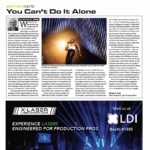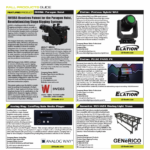Ash Nehru, one of the founders of d3 Technologies — which officially changed its name last month to disguise — is considered by many in the industry to be somewhat of a visionary.
Nehru, though flattered, declines the “visionary” moniker and thinks his success is really due to simply being observant, listening to clients and then working to solve the challenge. Nehru’s ability to identify the challenge and then develop a solution, d3, changed how the live entertainment industry approached and understood visualization. PLSN spoke with Nehru as he prepared for last month’s LDI show.
PLSN: How did you get start in the live entertainment industry?
Ash Nehru: When I came out of college [Cambridge University], where I studied computer science, I went to work for a games company doing 3D graphics. About three years in, they sacked me. Not because I couldn’t cut it but because I got really bored, and they knew it. I got into the gaming industry just because of real-time graphics aspect, it wasn’t the actual game aspect. I was always much more interested in poems, music, theater, film, and books; culture in general. I was never really a good fit in the game industry, that was just a job. I got a severance package for all of the work that I had done for them, and I used that money to start my own company. I came up with a program that created virtual Go-Go dancing robots.
Was there a big demand for virtual go-go dancing robots?
Oh yeah, huge! They were projected onto a screen with a lot of real time graphics. I did a lot of sound control, that sort of stuff. After a few years, another company dropped a ton of money in my lap to license that technology. So, I took that offer and took a year off. I traveled and during that year, I worked up the core that ended up becoming the basis of d3.
How did you end up in concert touring?
Around 2002, Matt [Clark] and Chris [Bird] had just designed a show for Massive Attack. They asked me to develop software to allow their vision to come through. Then one thing led to another, and they asked me to join them. Up to that point, I was messing around with projects on my own, and that was the first project where I worked in a team of people on a show, and it worked pretty well. I thought I was going to be sort of a solo artist. Then I discovered that that wasn’t the best way to run things. Together, we worked on climbing the ladder in concerts, and then we got to U2.
For U2’s tour [Vertigo; 2005-2006], we were hired to make content, but in order to show what we had done, we had to write a visualizer, so we did. That was when d3 was created. After that, it stayed as part of our in-house design kit. We were then approached by Marcel DeKeyzer of XL Video [now running New York-based IC Technologies], and that is what really started us on the path to d3 being a product.
Who have been some of the influential people in your career?
I think of all the people who enthusiastically adopted the d3 system before it was quite ready — before it was fully ready to actually do things — yet they were willing to take a chance on us. First was Smasher [Stefaan Desmedt], the video director for U2. He opened the door for us into the industry and really helped us understand working on that level show. Then Marcel, obviously; he really helped us by bringing d3 to a wider public. I would add Laura Frank, who really helped us understand the TV side, as well as Jason Rudolph, he is definitely someone that got us to think in ways that we weren’t thinking. On the big event side, both Bob Bonniol and Pablo Molina, who brought us onto the Marvel Universe Live! touring project. Darrel Maloney is one of the key people who got us into theater and has really helped us come up in that market.
What do you love about your job?
I think it’s problem-solving that I really like. Working with a really diverse array of different types of artists and types shows. It used to be just about music, but then it turned into theater, TV and then big corporate gigs. I love the really different and diverse kind of world that I get access to.
You don’t work in a vacuum, you have to actually go and observe people and watch them, and then you understand why this or that is a problem. Then you think about how to solve that problem. We have a team working on d3, and I make sure that we don’t create an ivory tower here. We get out on the road to get the feeling — the fun and the terror — of doing live shows.
What advice would you give to someone just coming up in the industry?
Give up, come and work for us! No, I’m kidding. I would say, find people to work with that aren’t exactly like yourself. Aim high, but be reasonable. You will fail along the way, so you might as well work on something difficult. Something where you learn.
What kind of project do you really love?
Any sort of project where you are trying to do something that hasn’t been done before. Some crazy challenge that just can’t be done any other way. You’re very close to being able to do it, but you’re going to have to do some work to make it happen.
What have been some of the craziest projects for you?
I think probably the craziest one would be the Super Bowl Halftime show with Katy Perry (Glendale, AZ, Feb. 1, 2015). I worked with Jason Rudolph. That was the one I was most terrified. Although, I didn’t let on at the time. The U2 360˚ tour, also [2009-2011]. That claw, with the massive expanding screen that opened and closed. I’d also add the Marvel Universe Live! arena tour project [launched in mid-2014]. That was a big project for us; that was huge.

What do you see coming next to the industry?
Well, I think the big thing that needs to happen in the industry is a common workspace. Currently, all show departments are all kind of siloed. So, the lighting department has their own visualizers; scenic has their own visualizer; cameras; automation; so on. Everyone is working separate from each other. I think the big step is everyone working together in the same virtual space. That’s where we’re hanging our hat on moving into the future.
For more information on disguise, please visit www.disguise.one.


